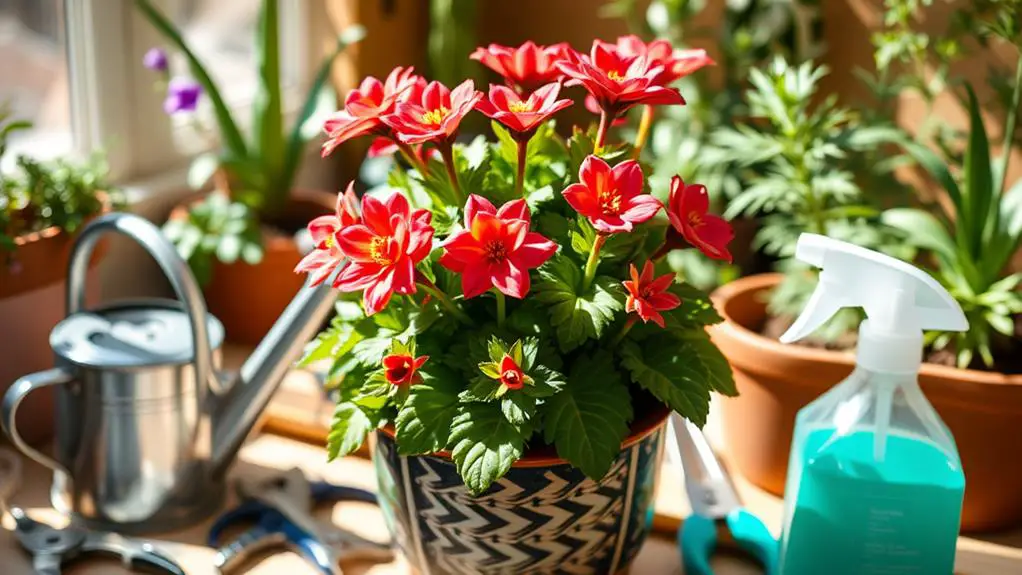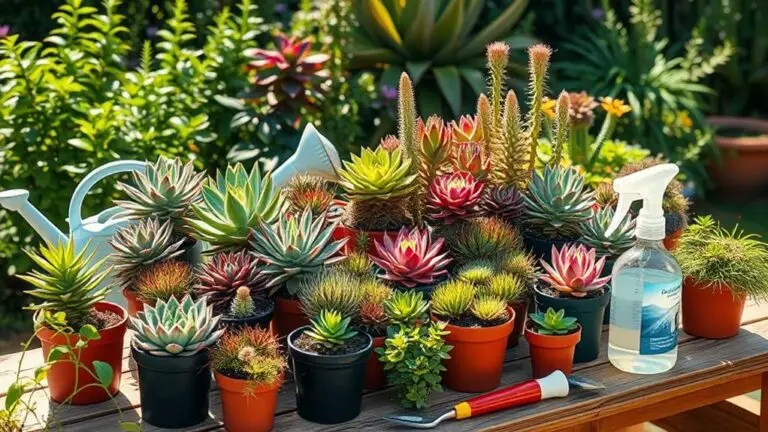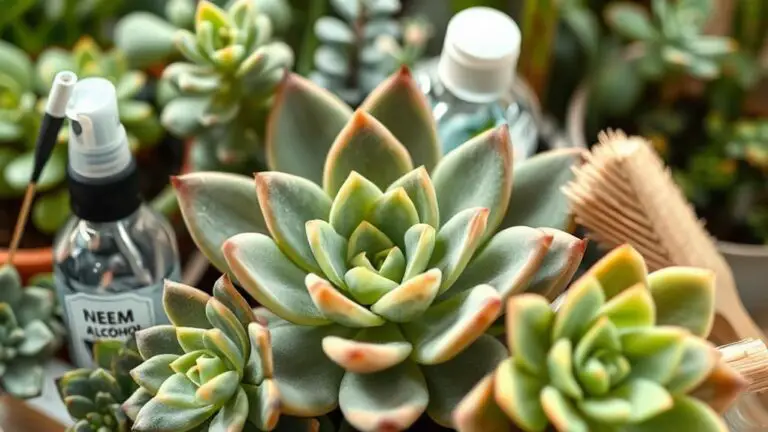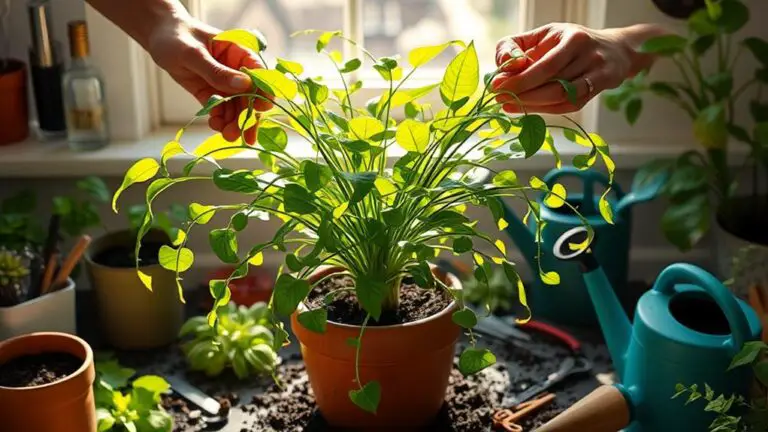7 Easy Steps to Care for Six-Angled Kalanchoe
Caring for your Six-Angled Kalanchoe doesn't have to be complicated. Start by choosing a bright and well-ventilated location, where temperatures stay between 65°F to 80°F. Next, focus on preparing well-draining soil by mixing potting soil, sand, and perlite. Once you've got the soil ready, adopting a soak and dry watering method is vital. But there's more to it than just watering; you'll also need to fertilize every 4-6 weeks during the growing season and prune in spring. Monitoring for pests and adjusting care during winter are also significant. Curious about the specifics of each step?
Choose the Right Location
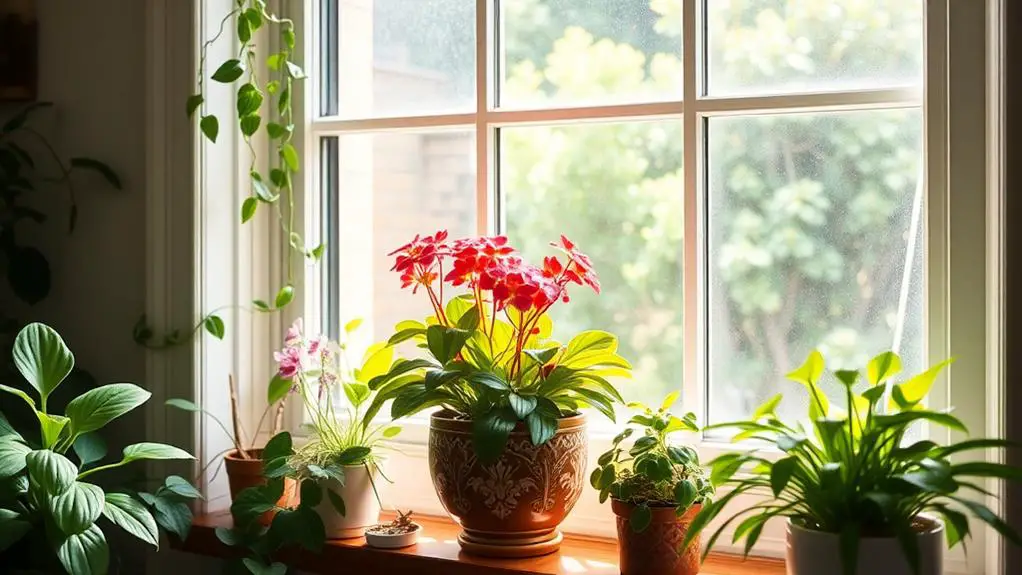
Choosing the right location for your Six-Angled Kalanchoe is vital for its health and growth. This unique plant thrives in bright indirect sunlight. A south-facing window is ideal because it provides ample light without exposing the leaves to direct sunlight, which can cause leaf scorch and damage its vibrant foliage.
Confirming the right light conditions will help your Kalanchoe flourish.
Temperature is another significant factor. The Six-Angled Kalanchoe prefers a warm environment, ideally between 65°F to 80°F. Make certain the location maintains this range and avoids cold drafts, which can stress the plant.
Keeping your home within this temperature range guarantees that your Kalanchoe remains comfortable and grows well.
Humidity levels also play a role. This plant doesn't like high humidity; it does best in drier conditions, around 30%-50%. So, avoid placing it in overly humid rooms like bathrooms.
Proper airflow is essential, too. Good ventilation helps prevent mold and mildew, contributing to the plant's healthy growth. Confirm that the location has adequate airflow without being too windy.
Prepare Well-Draining Soil
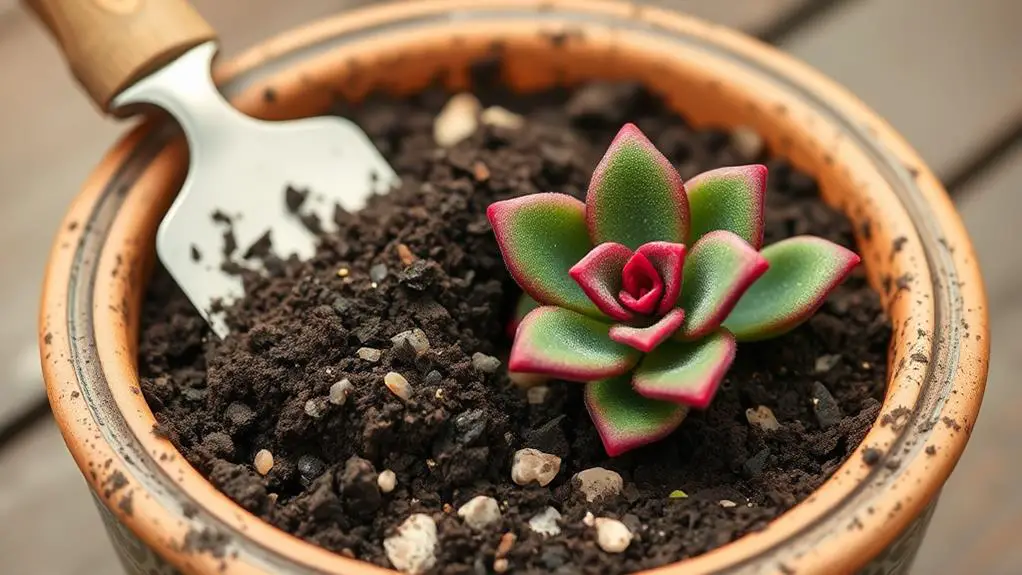
Preparing well-draining soil is crucial for the health of your Six-Angled Kalanchoe. To start, use a potting mix designed for succulents or cacti. This specific soil mix guarantees proper drainage and aeration, which is essential for your Kalanchoe's roots. For a suitable blend, combine regular potting soil with sand and perlite in a 2:1:1 ratio. This mixture helps reduce the risk of root rot by promoting good drainage.
Next, make certain the pot you choose has drainage holes at the bottom. These holes allow excess water to escape, preventing waterlogging. Adding a layer of gravel or small rocks at the bottom of the pot can further improve drainage and promote healthy root development.
| Ingredient | Ratio | Purpose |
|---|---|---|
| Potting Soil | 2 | Base for nutrients and structure |
| Sand | 1 | Enhances drainage and aeration |
| Perlite | 1 | Improves soil aeration and drainage |
Regularly check the moisture levels of the soil. Allow it to dry completely between waterings to maintain ideal conditions for your succulent. This practice prevents overwatering, which can lead to root rot. Remember, well-draining soil is key to keeping your Six-Angled Kalanchoe happy and healthy!
Proper Watering Techniques
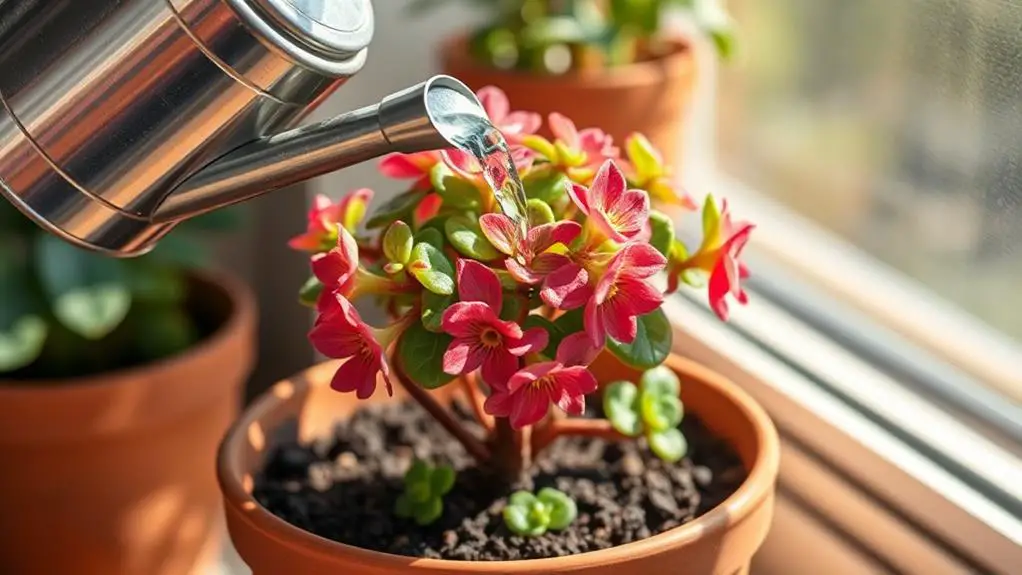
When watering your Six-Angled Kalanchoe, use the soak and dry method—thoroughly soak the soil, then let it dry out completely before watering again.
Watch for signs of overwatering like yellowing leaves and mushy stems, as these mean you need to adjust your schedule.
This careful approach will help keep your plant healthy and happy.
Soak and Dry Method
The soak and dry method is an effective way to guarantee your Six-Angled Kalanchoe thrives. To start, thoroughly water your plant until water drains from the bottom of the pot. This confirms the soil is fully saturated.
After watering, let the top inch of soil dry out completely before you water again. This prevents overwatering and root rot, which can seriously harm your plant.
You should typically water every 1-2 weeks, but keep an eye on the environment. Humidity and temperature can affect how quickly the soil dries out.
Using well-draining soil, like a cactus or succulent mix, is vital. It helps the soak and dry method work effectively by allowing excess water to escape, keeping the roots healthy.
Watch for signs of overwatering, such as yellowing leaves and mushy stems. These indicate that the plant is getting too much water.
On the other hand, shriveled or browning leaves mean it needs more water. By paying attention to these signs and adjusting your watering schedule accordingly, you'll create a healthy environment for your Six-Angled Kalanchoe.
This method is simple but essential for keeping your plant vibrant and strong.
Signs of Overwatering**
Overwatering is one of the most common mistakes made with Six-Angled Kalanchoe. When you give your plant too much water, it can show several signs of stress. Look out for yellow leaves and mushy stems; these are clear indicators of root rot caused by excessive moisture.
To avoid this, you should use the soak and dry method, which means letting the soil dry out completely before watering again.
To help you identify and prevent overwatering, follow these steps:
- Check soil moisture: Feel the top inch of soil. If it's still damp, don't water your plant yet.
- Watch for yellow leaves: Yellowing leaves can mean the roots are too wet.
- Prevent leggy growth: If your plant starts to stretch towards light, it might be a sign of overwatering combined with poor light conditions.
- Adjust your watering schedule: Monitor your plant regularly and change your watering habits based on environmental conditions and seasonal changes.
Proper Kalanchoe care means being aware of your plant's needs and adjusting as necessary.
Fertilize Wisely

To achieve ideal growth for your Six-Angled Kalanchoe, fertilizing wisely is key. Start by using a balanced fertilizer with an NPK ratio of 10-10-10 or 20-20-20. Apply this every 4-6 weeks during the growing season, from spring to early fall, to promote maximum growth. This regular feeding provides essential nutrients your plant needs to thrive.
During the dormant winter months, resist the urge to fertilize. Your Kalanchoe doesn't need extra nutrients when it's not actively growing. Over-fertilization can cause nutrient buildup in the soil, leading to potential damage. Stick to the recommended guidelines to avoid this issue.
Slow-release fertilizers are another great option. Sprinkle them on the soil surface and water lightly to allow a gradual nutrient supply. This can make feeding simpler and more consistent over time.
Always monitor your plant's response after fertilizing. If you notice any signs of distress or slow growth, adjust the type and frequency of fertilizer. Proper watering practices also play a significant role in preventing salt buildup from over-fertilization.
Prune Regularly
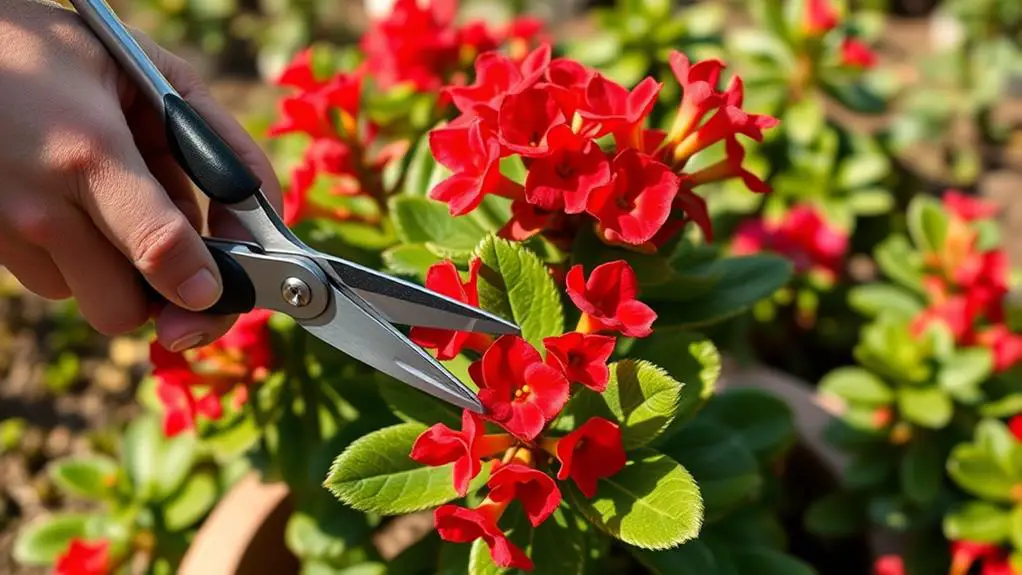
To keep your Six-Angled Kalanchoe healthy and looking its best, prune it regularly starting in early spring.
Use clean, sharp scissors to cut away dead or yellowing leaves, damaged stems, and spent flowers, which helps prevent infection.
Regular trimming also stops the plant from becoming leggy and encourages a neat, compact shape.
Timing for Pruning
Pruning your Six-Angled Kalanchoe is essential for maintaining its health and appearance. You should prune in early spring or early summer when the plant is in its active growth phase. This timing helps encourage new growth and maintain the plant's shape.
Regular pruning prevents legginess, promotes bushier growth, and keeps the plant looking compact. It also allows you to monitor the plant's health and remove any dead or dying leaves that might affect its liveliness.
Here's a simple guide to help you with pruning:
- Timing: Prune in early spring or early summer to coincide with the plant's active growth phase. This timing helps encourage new growth and maintain a healthy shape.
- Health Check: Regularly monitor your plant's overall health. Look for dead or dying leaves, damaged stems, and spent flowers that need to be removed.
- Shape and Growth: Trim excess growth to maintain a compact appearance. This helps prevent legginess and promotes a bushier growth habit.
- Stress Signs: If your plant starts showing signs of stress, such as yellowing leaves or drooping, it might be time for a light pruning to rejuvenate it.
Tools and Techniques
With your pruning schedule in mind, it's important to understand the right tools and techniques to keep your Six-Angled Kalanchoe in top shape. First, confirm you have clean, sharp scissors. Using dirty or dull tools can harm the plant and increase the risk of infection.
Prune in early spring or early summer to encourage new growth and maintain your plant's compact shape. Start by removing any dead or yellowing leaves, damaged stems, and spent flowers. This helps the plant focus its energy on healthy growth.
Additionally, regularly trim excess growth to prevent legginess, which often occurs when the plant doesn't get enough light. But be cautious—don't over-prune. Removing more than one-third of the plant at once can stress it.
After pruning, monitor your Kalanchoe to confirm it adapts well. Check for signs of new growth and overall health. If the plant appears stressed, give it some extra care, like checking light levels and watering appropriately.
These techniques will help your Six-Angled Kalanchoe thrive and stay beautiful. With the right approach, your plant will be vibrant and healthy all year round.
Monitor for Pests
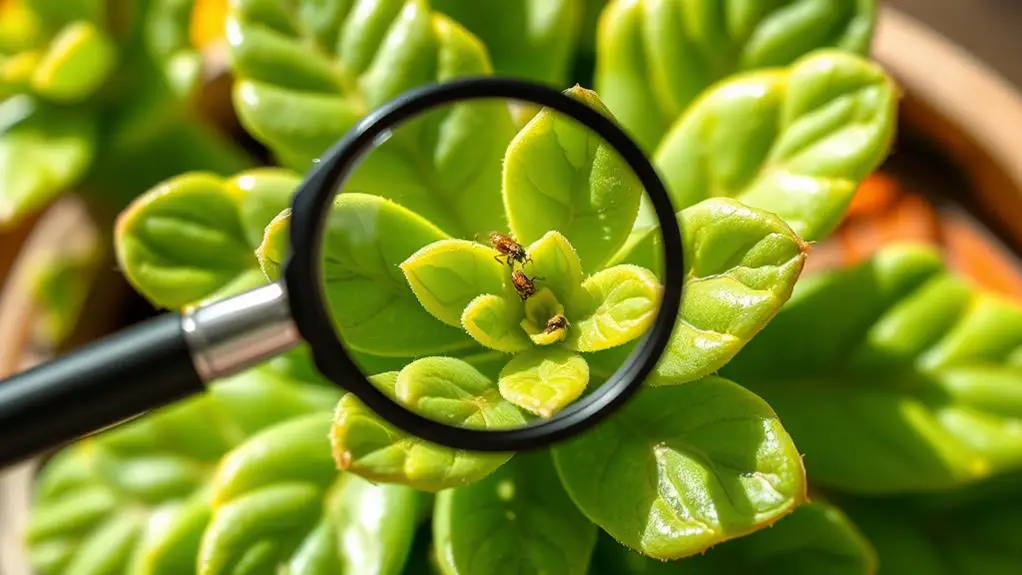
As you care for your Six-Angled Kalanchoe, regularly inspecting it for pests is crucial to maintaining its health. Pests like mealybugs, scale insects, and spider mites can cause significant damage if infestations aren't caught early.
Monitor the plant closely for signs of pest activity. Look for sticky residue, webbing, or distorted leaves, as these are clear indicators that pests might be present.
Here are some steps to help you manage pests:
- Wash off pests: Use a gentle stream of water to wash off any pests found on the leaves. Pay special attention to the undersides where pests often hide.
- Introduce natural predators: Consider adding ladybugs or lacewings to your garden. These natural predators can help control pest populations in an environmentally friendly way.
- Apply insecticidal soap: If you notice persistent infestations, insecticidal soap can be an effective treatment. Follow the manufacturer's instructions to guarantee safe application.
- Use neem oil: Neem oil is another excellent option for treating pests. It disrupts the lifecycle of many insects, helping to keep your kalanchoe healthy.
Winter Care Tips
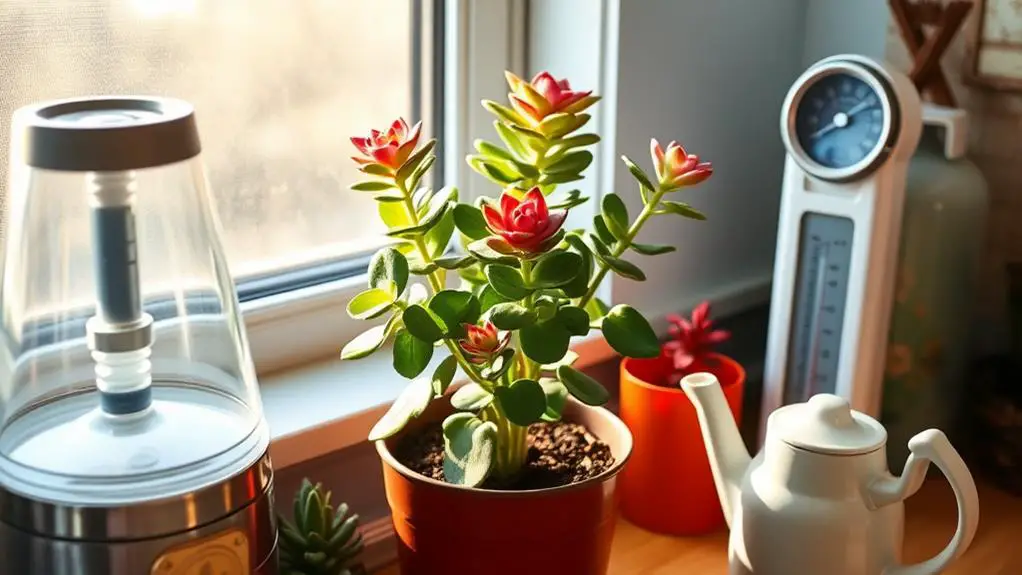
After guaranteeing your Six-Angled Kalanchoe is pest-free, it's important to adjust your care routine for the winter months. Start by reducing watering to every 2-4 weeks, allowing the top inch of soil to dry out to prevent overwatering and root rot. Place your plant near south or west-facing windows to provide 6-8 hours of indirect sunlight daily, which is vital for Kalanchoe health.
Maintain indoor temperatures between 15°C to 20°C (59°F to 68°F) and keep humidity levels around 40-60% for ideal winter growth. Confirm proper air circulation around your plant to avoid stagnant air, which can cause problems. Additionally, monitor for frost damage, as temperatures below 10°C (50°F) can harm your Kalanchoe.
Twice during the winter, apply a diluted, balanced fertilizer every 6-8 weeks. This will help the plant recover from dormancy and promote healthy growth in the spring.
Here's a quick reference table for your winter care:
| Task | Frequency | Notes |
|---|---|---|
| Watering | Every 2-4 weeks | Allow top inch of soil to dry |
| Sunlight | Daily | 6-8 hours of indirect sunlight |
| Temperature | Constant | 15°C to 20°C (59°F to 68°F) |
| Humidity | Constant | 40-60% |
| Fertilizing | Every 6-8 weeks | Use diluted, balanced fertilizer |
Frequently Asked Questions
Do I Water Kalanchoe From the Top or Bottom?
You can water Kalanchoe from the top or bottom. Top watering is preferred, ensuring water seeps through and drains. Bottom watering works too; just place the pot in a dish of water for 30 minutes.
How Do You Care for a Kalanchoe Plant Indoors?
Place your Kalanchoe near a south or west-facing window for bright light. Water every 1-2 weeks, letting the top inch dry. Use well-draining soil and pots with drainage holes. Maintain 65-80°F and 40-60% humidity.
Where Is the Best Place to Plant a Kalanchoe?
You should plant a kalanchoe in a bright, indirect light location, such as near a south-facing window. If outdoors, choose partial shade to avoid leaf scorch. Ascertain temperatures stay between 65°F and 80°F, avoiding frost.
How Do You Take Care of a Kalanchoe Plant in the Summer?
Place your Kalanchoe in bright, indirect sunlight for at least 6 hours daily. Water every 1-2 weeks, letting the soil dry out completely between waterings. Fertilize every 4-6 weeks and maintain temperatures between 65°F to 80°F.
Conclusion
Caring for your Six-Angled Kalanchoe doesn't have to be hard. By following these seven simple steps, you'll create a healthy environment for your plant. Choose the right spot, prepare well-draining soil, and water properly. Don't forget to fertilize and prune regularly. Keep an eye out for pests and adjust your care during winter. With a bit of attention and love, your Kalanchoe will thrive, making your gardening journey rewarding and enjoyable. You've got this!

